|
|
1865 – 2015 - from beginnings to modern times
150 years of corporate history have made the WILKA company into what it represents today. Even now, all the company’s shareholders are descended from the lines of the 6 children born to Wilhelm Karrenberg and his wife Wilhelmine. WILKA is proud to still be a family-run business that determines its own course. |
| 1865 |
1900 |
1920 |
1925 |
1945 |
1960 |
1970 |
1980 |
1990 |
2000 |
2015 |
2020 |
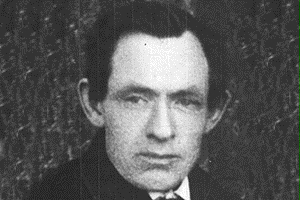 1865 1865
Wilhelm Karrenberg began to assert his independence in his residence “Am Schnorrbeutel” in Velbert in 1865, carrying on his business with a few files and small tools of his trade. The house was rather isolated which was probably the reason for keeping a lookout for another apartment. This was found in “Heidefeld”, a small half-timbered house with a small workshop (smithy) attached. The move took place in 1869.
The house in Heidefeld existed until the end of the 1950s on the site of which is now owned again by the company - approx. 200 metres from the current location of the main factory.
The company grew steadily and the owner’s three sons, Julius, August and Ernst, all started work in their father’s company after leaving school. The eldest son Julius joined the company in 1874, August in 1884 and Ernst, the youngest son, in 1886.
A record from the year 1888 shows the company founder with his three sons, three workers and one apprentice. The apprentice who came from Mülheim was called “Bubsche”.
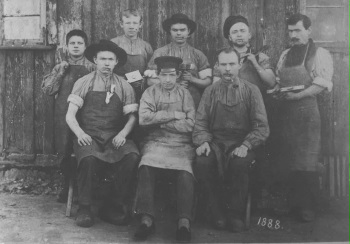 1900 1900
The move into the new factory space, a shed structure, was made in 1895. Five months later, the residential building which was constructed on the Wülfrather Strasse was ready to move into.
The technique of lock manufacture was changing. Until this time, work was only carried out on manual presses, only files were used for surface finishing. Manufacturing locks was pure craftsmanship. The move to mechanically driven presses was made in the new building; the surfaces were ground on grinding stones or emery wheels. A 6 hp gas engine provided the driving power for the machines. Only three years later, the new building from 1895 was expanded by the addition of a boiler and engine house. A grinding plant was set up in a further extension. A significant annex by the standards of the day was built in 1903 and is currently the metalworking shop. 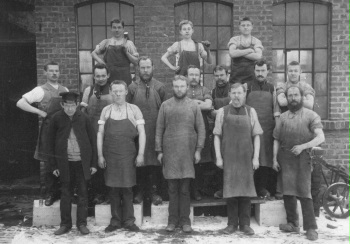 1920 1920
Wilhelm Karrenberg transferred the company to his three sons while he was still alive since he was already 60 years old when the relocation took place. The first entry in the commercial register of 28 June 1901 named his sons, Julius, August and Ernst, as shareholders of the general partnership. The founder withdrew completely from management. The First World War brought with it great difficulties. Almost all the company staff were called up, even if not immediately. The owners’ sons who worked in the company also had to become soldiers. Two of them, namely Fritz and Ernst jr., did not return after the war. Ernst, the youngest of the three owners, was drafted. Julius, the eldest, worked himself into the ground and suffered a health breakdown at the end of 1915. As a result, it was possible to release Ernst from military service so that he could take over management of the company. Thus it was possible in 1916 to bring some life back into the company which until then had given the impression of having died out completely. The company managed to carry on until the end of the war with just a few staff, mainly women. The lathes were used for turning hand grenades, cartridges were riveted on the presses and in addition snaffle and curb bits were manufactured.
Wilhelm Karrenberg died before the end of the war in 1916 and his wife outlived him by a further 6 years. 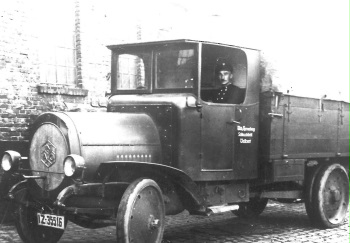 1925 1925
After the war ended, the company resumed the production of door locks. The fact that an extension was built to accommodate part of the pressing plant and the tool making plant in 1921 shows how quickly efforts were made to further expand production. This new building also had a basement. The basement was used to expand the material store. The complex was thus extended up to what was then Lindenstrasse, now Feuerdornstrasse. During the French occupation of the Ruhr in 1923, Velbert was part of the “occupied area”. In addition to this fact, inflation brought about a lot of unrest and unpleasantness. In its efforts to get goods into the rest of Germany in spite of the French customs block and thus to maintain work for as long as possible, the company became entangled during this period of “passive resistance” in a lawsuit due to non-observance of French customs regulations which was settled in front of a French court in Düsseldorf. It ended in a fine which was later reimbursed by the German Reich. However, this was purely a nominal reimbursement as soon all scales of value were lost during this period of massive inflation. The columns of the accounting books were no longer able to accommodate the huge figures until the introduction of the Rentenmark put an end to the spectre. The exchange rate of the new Rentenmark to the old Mark was 1 : 1,000,000,000,000 (1 trillion).
This period also saw the first motorization of the company. A truck by NAG was acquire in 1923. This was followed two years later by the purchase of the first passenger vehicle, an Opel saloon. 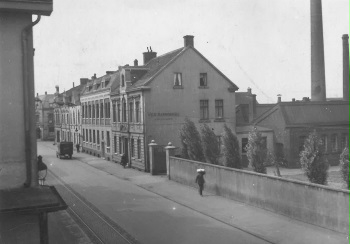 1945 1945
During the period between the two world wars, management was in the hands of Ernst, the founder’s youngest son, and Karl, the eldest son of Julius Karrenberg. Karl’s siblings received their inheritance as limited partnership shares with the result that the company took on the legal form of a limited partnership. One of the limited partners, Otto Karrenberg, worked in the company from the end of the 1920s until 1947.
August, the founder’s second son, worked in the company until the outbreak of the Second World War. The only son he was left with was Eugen. He managed the shipping department. Economic conditions were good until 1928. However, then the global crisis set in. There was unemployment, the like of which had never been seen before. Years of reduced working hours brought hardship and despair not only to the workers but the company also used up its reserves. The poor economic situation for our sector of the economy continued until well into the 1930s; it was the last few years before the Second World War before there were any signs of recovery. Ernst died shortly before the outbreak of the war in 1939. His son, Walter, who had been working in the company’s commercial section since 1917, entered the management.
The 2nd World War created a similar situation to that of the first. It should be emphasized particularly at this point that, unlike many others, the company had no need of war. As evidence of this, it should be noted that work on manufacturing war items did not start until long after war broke out and only after the employment office had begun to take away the employees. It was only possible to keep up lock production on the smallest scale. The machining facilities, expanded by several lathes, was changed over to the production of military goods. The initial years after the war were tough until the currency reform created the basis for a new revival. The tool making plant was the first department to be completely modernized in 1945/46. 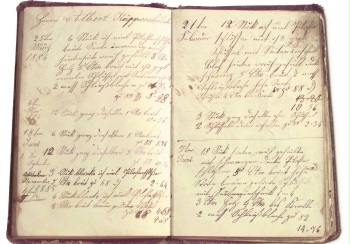 1960 1960
In the years 1952/53, production started on the first profile cylinders whose breakthrough only came at the end of the 50s. This was significant progress towards the standardization of this production sector.
Women were first employed in lock assembly in the winter of 1954/55. In the first half of the 1950s, death reaped a rich harvest among the ranks of the shareholders and executive staff. August Karrenberg died in 1950. The generation of the founder’s sons died out with him. His son Eugen, who had contracted a serious illness during the war, followed him in 1953. Karl’s death in 1954 was a heavy loss for the company. His place in the management was taken by his son Friedrich who was born in 1924. He ushered first representatives of the fourth generation into the company’s management. Walter Karrenberg died in 1956, his brother Dr. Wilhelm Karrenberg entered the company as an authorized representative.
A new type of lock, developed in America, had caught on not only in the USA but also in Central and South America generally. We call it the “knob lock” but the American name for it is the “tubular lock” because the lock mechanism is located inside a tube. The tubular lock had nothing in common with the conventional type of locks such as were manufactured in Velbert. Kriesten, who later became the works manager, developed a complete range which remained the only one of this type manufactured in the Federal Republic of Germany until the 1990s.
The company continued to grow and grow and by 1957 the workforce had risen to approx. 150.
Time studies (in money terms) began in the lock section in the 1950s in order to build up a performance-based pay system and in 1958 studies were carried out in cylinder construction with the introduction of standard times. The introduction of technical drawing in 1957 proved to be a significant step towards recording and manufacturing with greater precision. Theoretical apprenticeship training was introduced alongside practical training at the end of the 1950s. 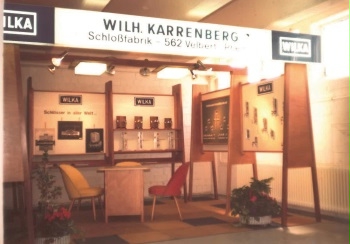 1970 1970
The painting plant was completely modernized in 1962. The residential building at Wülfrather Strasse 56 was purchased additionally in 1965. Apartments for employees were created here and it accommodated the joiner’s workshop. At the end of the 1950s and beginning of the 1960s, conditions were laid down for a more contemporary process in the area of operational organization. Design card indexes were constructed and installed first in the tube lock and cylinder sections and then also in the lock section. In addition to introducing bonus systems in the 1960s, the development of a target-performance comparison meant that a start could also be made on introducing a large number of cost centres.
Dr. Wilhelm Karrenberg, who had supervised the financial accounting operations in the company, died in May 1965.
The years from 1966 onwards were particularly important with regard to the machining equipment for the cylinder section.
The company produced quite a few of these machines itself in-house and they made a valuable contribution to technical enrichment. In the lock section, alongside investments in machinery, it was mainly other materials, such as die-cast or galvanized parts, that were crucial to an obvious streamlining of production.
At the end of the 1960s the requirements imposed by the trade inspectorate became increasingly onerous. In this area, however, the company was particularly progressive and this was demonstrated in that the trade union sometimes took photographs to illustrate the exemplary installations on the company’s premises. By 1970 the company already had a workforce of 280. 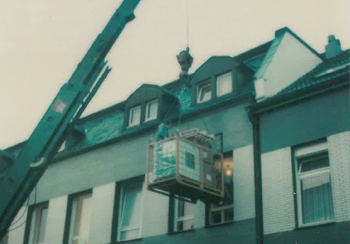 1980 1980
The first bitting machine for 6-pin cylinders came in 1973. This brought a significant turnaround - the variety of different versions became larger and, after a short time, the company was the first supplier of standard cylinders that were 6-pin across the board for a normal installed length. In 1979, the company was granted a patent for sloping key cuts which opened up access to the market of large lock and key systems. This took place in conjunction with a new generation of profiles that created individualization of the key profile for the first time ever in the area of cylinder technology - the WILKA trade mark could be read in the profile.
The 70s marked the birth of the tubular frame locks in the lock sector. A respectable range was built up here due to the extensive use of aluminium and synthetic profiles in door construction. The first anti-panic lock followed in 1979. The first multi-point locking system was set up virtually as the pioneer in Germany in 1978. It was replaced in 1985 by a complete range - a contribution to the increasingly great need for security due to the rising burglary rate during these years.
Approx. 290 employees were recorded in the company in 1980. 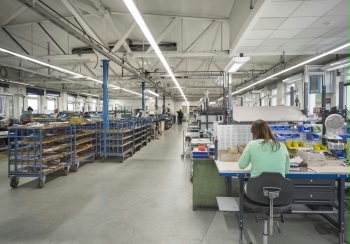 1990 1990
The year 1989 will always remain a bad memory within the company. Mr Friedrich Karrenberg died unexpectedly after more than 30 years of sole responsibility as the managing partner. During the years he was in charge, he had led the company to become a successful and healthy business. As none of the shareholders from the group of those remaining could take over the management, the company name was changed to WILKA Schließtechnik GmbH as of 01.01.1990. The Karrenberg name was retained in the separated holding company, Wilhelm Karrenberg GmbH + Co. The shareholder meeting appointed Mr Hans-Joachim Rust, son of co-owner Ms Ruth Rust and Mr Wolfgang K. Schlieper, son-in-law of the late Mr Friedrich Karrenberg, as successors on the management board. Both had worked in the company for years and they divided up the divisions among themselves according to the areas they has been entrusted with up to that point. The company had a workforce of approximately 300 at the beginning of 1990. 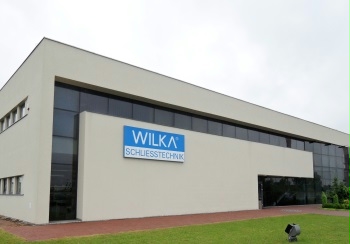 2000 2000
Electronic aids such as the CAD system and the archiving system were adopted into everyday use in 1991 and 1994, and the first laser cutting machine was installed in 1995. It could be used to manufacture small series and samples with a previously unknown speed and precision.
Flexi-time was introduced for the employees at the beginning of 1994 and the first company restaurant opened its doors in the same year.
In 1996, the company’s quality control section was awarded certification to DIN EN ISO 9001.
The first WILKA reversible key system was launched on the market in 2001. It established itself in the top security segment. In the lock section, cross bar locks and additional locks in unusual designs created a distinctive step. To counteract the long-term decline in the construction market in Germany, the first subsidiary was opened in Leszno, Poland in autumn 2001. The aim here was to support the future markets of Eastern Europe with a local service. The first step, in addition to appointing an external sales force, was to set up a warehouse. The first robot was employed in the production section at the end of 2001 - a system for the fully automated manufacture of reversible keys. Hans-Joachim Rust died suddenly in March 2003 and Wolfgang K. Schlieper was entrusted by the shareholders with the sole management.
The key skills in the tubular frame sector were underlined by the development of complete solutions for escape doors in this segment. 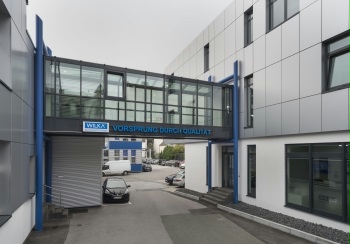 2015 2015
In 2008 the company participated as one of the co-initiators in the regional initiative for the creation of a university institute for hardware and security technology. Associated with this was an annual grant over five years in the launch phase. It was an expression of the ties to the region and to the Velbert site.
2008 was also the year in which WILKA introduced the first electronic cylinder based on the internationally widespread Mifare standard. 2009 as the year of the global financial crisis also left its mark on WILKA even if they were considerably smaller compared to other industries. The downturns focused particularly on individual export markets. Unlike other sector enterprises, there was no need to resort to reduced working hours or redundancies which led, however, to an increasing proportion of staff costs.
The emphasis among the products was on a completely new range of locks in the tubular frame sector. New versions to combat current burglary methods were required in the cylinder section. 2010 began with the entry of the 6th generation of the family in the person of Robert Schlieper. He started in the technical section in order to acquire sufficient knowledge of products and production. The experiences of the past years with changed priorities and also the difficulties in individual export markets necessitated reorganization of the sales section. With more than 5 million euros, 2012 brought the highest investments in the company’s history so far. Among other things, the world’s largest broaching bench for cylinder cores was installed with the other machines. After many years, a new administrative building created a striking symbol. A state-of-the-art sales and training building was created during a good 5-month construction period.
In 2015, the company can look back on a 150-year tradition and the stories of the old days can still be seen in many places. 2020
2016 was marked by a change of management. After 27 years, Wolfgang K. Schlieper handed over the position of managing director to his son Robert Schlieper; continuing to run the family business in the 6th generation.
In the same year, the company took the first steps of a large restructuring plan within the production department. The plan included investments of more than 7 million euros over the next two years to update machinery and simultaneously increase the firms production capacities as well as an optimising the production processes. As a result, an additional production area of 1.600 m² could be harnessed.
2017: The range of product development in the metal lock, cylinder and electronics sectors clearly showed the company's innovative spirit. Focusing on the metal construction industry was very successful and after thorough consideration the production of wooden locks was discontinued.
2019: With the "WILKA - Fit for Future Strategy", which will run until 2030, the company is realigning itself to meet the changing market requirements. The implementation of the strategy ensures both profitability as well as employee and customer satisfaction in the long term.
|
|



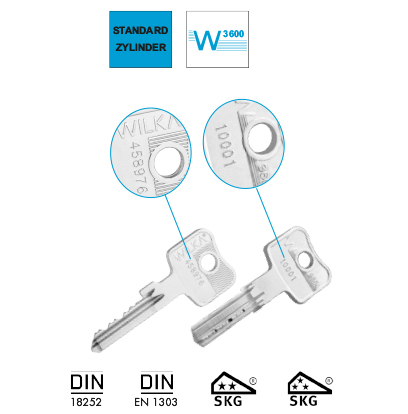


 1865
1865 1900
1900 1920
1920 1925
1925 1945
1945 1960
1960 1970
1970 1980
1980 1990
1990 2000
2000 2015
2015